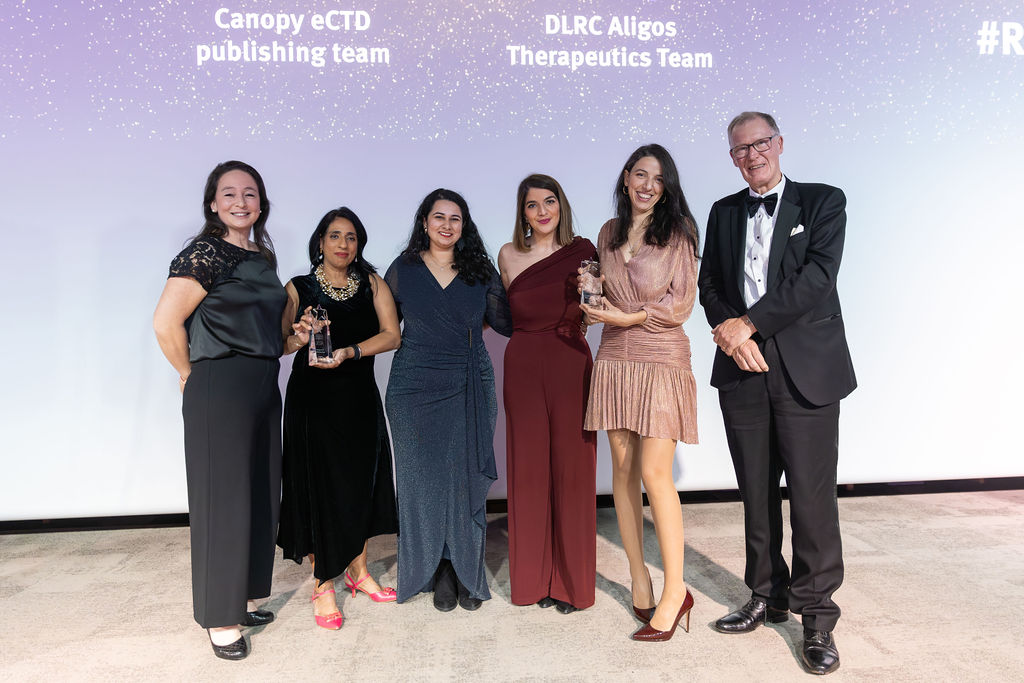Press Release
DLRC Celebrates Double Success at TOPRA Awards for Regulatory Excellence 2024
Published 03rd December 2024

DLRC has achieved a remarkable double victory at the TOPRA Awards for Regulatory Excellence 2024, winning both the Contribution and Support awards. These accolades highlight DLRC’s outstanding commitment to regulatory excellence and supporting global healthcare innovation.

Michelle Blake Wins the Contribution Award
The Contribution Award was presented to Michelle Blake, Associate Director and Senior Consultant at DLRC. This prestigious recognition reflects Michelle’s unwavering dedication, exceptional leadership, and ability to inspire and support colleagues and clients.

Michelle’s contributions include mentoring team members across all levels and guiding clients through complex regulatory challenges with expertise and care. She has become a role model within DLRC and the regulatory community, embodying the company’s integrity, collaboration, and excellence values.
Michelle has previously been recognised as a finalist in the Horizon and Inspiration categories, further cementing her legacy of professional excellence.
Aligos Therapeutics Team Takes Home the Support Award
DLRC’s Aligos Therapeutics Team was awarded the Support Award for their exceptional collaborative efforts across the UK, EU, and US.

The award-winning team includes:
- Greg Dombal, President (US)
- Wafa Bouaziz, Managing Director and Head of Regulatory Affairs (EU)
- Roy Pengilley, Senior Regulatory Consultant (EU)
- Sharon Robinson, Associate Director and Senior Regulatory Consultant (UK)
- Jo Brady, Senior Regulatory Consultant (UK)
- Sowjanya Pushpala, Senior Publishing Consultant (US)
- Carolina De La Portilla, Regulatory Consultant (EU)
- Tiankun Ren, Regulatory Executive (EU)
- Rose Prizzi, Regulatory Associate (US)
Although the core team is listed, this achievement reflects the collective efforts of DLRC’s global team, with members from across the organisation providing invaluable input and support to the Aligos Therapeutics Team at various stages.
The team consistently delivers innovative solutions under tight deadlines. Their teamwork, determination, and ability to provide exceptional support have set new benchmarks for regulatory consultancy. This win celebrates their significant contributions and dedication to exceeding client expectations.
Recognising Outstanding Finalists
In addition to the winners, Wafa Bouaziz was a finalist in the Inspiration category, and Anuya Aras in the Horizon category. Both were recognised for their impactful contributions to regulatory affairs, showcasing DLRC’s depth of talent and expertise.

An Evening of Inspiration
The TOPRA Awards ceremony celebrated the transformative work of regulatory professionals, highlighting their vital role in advancing healthcare globally. DLRC thanks TOPRA for hosting such an inspiring event and congratulates all finalists and winners for their achievements.

About DLRC
DLRC is a leading regulatory affairs consultancy that supports pharmaceutical and medical device companies of all sizes, from global organisations to innovative start-ups. The company offers tailored, phase-appropriate regulatory strategies and provides expert guidance from early development through to post-licensing activities.
With a global team of specialists in non-clinical, CMC, clinical, and MedTech fields, DLRC has supported over 130 clients across diverse regulatory jurisdictions. The company is known for its agility, integrity, and ability to deliver bespoke solutions that drive success. Whether offering standalone services or full regulatory outsourcing, DLRC continues to set the standard for excellence in the life sciences industry.
Media Contact
Laura Wright
Marketing Manager, DLRC
laura.wright@dlrcgroup.com